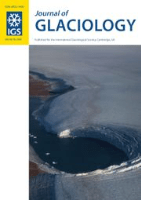
JOURNAL OF GLACIOLOGY
Scope & Guideline
Driving innovation in the study of ice and climate interactions.
Introduction
Aims and Scopes
- Glacier Dynamics and Ice Flow:
Research on the mechanics of glacier movement, including sliding, calving, and the effects of subglacial hydrology on ice dynamics. - Climate Change Impacts on Glaciers:
Investigations into how climate variability and change affect glacier mass balance, melt rates, and glacier retreat. - Remote Sensing and Monitoring:
Utilization of satellite and aerial imagery, as well as ground-based measurements, to monitor glacial changes and dynamics. - Ice Sheet Modeling:
Developing and applying models to simulate past, present, and future behavior of ice sheets and glaciers under various climatic scenarios. - Physical and Chemical Properties of Ice:
Studies focused on the microphysical properties of ice, including its thermal, mechanical, and optical characteristics. - Subglacial Processes and Hydrology:
Exploration of water flow beneath glaciers, its impact on ice dynamics, and the role of subglacial lakes. - Field Studies and In Situ Measurements:
Empirical research involving fieldwork to collect data on glacier behavior, mass balance, and environmental conditions.
Trending and Emerging
- Impact of Climate Change on Glacier Dynamics:
There is an increasing emphasis on understanding how climate change affects glacier dynamics, mass loss, and contributions to sea level rise. - Use of Advanced Remote Sensing Technologies:
Emerging themes include the utilization of drones, satellite imagery, and machine learning for glacier monitoring and data analysis. - Subglacial Hydrology and Ice-Sheet Stability:
Research focusing on the interactions between subglacial water systems and ice sheet stability is gaining traction, highlighting its importance in glacier dynamics. - Interdisciplinary Approaches:
A trend towards integrating glaciology with other disciplines such as hydrology, geology, and climate science is becoming more common. - Hydrological Modeling and Mass Balance Studies:
Refined modeling approaches that incorporate complex hydrological processes and mass balance are emerging as critical themes in glaciological research.
Declining or Waning
- Traditional Glacier Mapping Techniques:
Older methods of glacier mapping and monitoring may be waning as more advanced technologies such as UAVs and satellite remote sensing become prevalent. - Generalized Ice Core Studies:
Research focusing solely on ice core data without integrating broader glaciological or climatic contexts has become less prominent. - Glaciological Studies Without Climate Context:
Papers that do not link glaciological findings to broader climate change discussions are appearing less frequently, as interdisciplinary approaches gain importance. - Localized Case Studies:
The trend towards global or regional assessments may be overshadowing localized studies that do not contribute to larger-scale patterns or implications. - Purely Theoretical Modeling:
Research that does not incorporate empirical validation or field data is becoming less common, as there is a growing emphasis on model-data integration.
Similar Journals
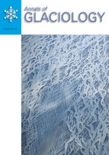
ANNALS OF GLACIOLOGY
Illuminating the Dynamics of Ice and ClimateANNALS OF GLACIOLOGY, published by Cambridge University Press, is a premier open-access journal tailored for the field of glaciology and cryospheric sciences. Established in 1980, the journal has become a vital resource for researchers and professionals analyzing the multifaceted interactions between glaciers, ice sheets, and the Earth's climate system. With a commendable Q1 status in Earth-Surface Processes for 2023 and a commitment to open access since 2016, ANNALS OF GLACIOLOGY provides unparalleled visibility and accessibility for cutting-edge research, fostering global dialogue and innovation among scientists. The journal features a broad scope, encompassing both fundamental studies and applied research on glacial characteristics, behavior, and their environmental impacts. Located in Cambridge, England, this journal is particularly essential for those engaged in the ongoing exploration of our planet's cryospheric changes, their implications, and their relevance to climate science.

Earth Interactions
Connecting Disciplines, Unraveling Earth’s MysteriesEarth Interactions is a prominent journal that serves as a critical platform for interdisciplinary research in the field of Earth and Planetary Sciences. Published by the American Meteorological Society, this journal has established itself as a key resource for scholars, researchers, and professionals dedicated to understanding Earth's complex systems and their interactions. With an impressive Q1 ranking in the category of Earth and Planetary Sciences for 2023, it reflects a commitment to high-quality scholarship and impactful contributions to the field. The journal, with its dedicated coverage from 2004 to 2024, encompasses a wide array of topics, providing comprehensive insights into geological, atmospheric, and environmental phenomena. Although it operates under a non-open access model, its significance is underscored by its placement in the top percentile of Scopus rankings (Rank #89/195), making it an exciting resource for those pursuing advanced studies and applications related to Earth's systems.

Cuadernos de Estudios Gallegos
Exploring the Depths of Galician HeritageCuadernos de Estudios Gallegos is a prestigious academic journal dedicated to the interdisciplinary study of Galician culture and history, published by the CONSEJO SUPERIOR INVESTIGACIONES CIENTIFICAS-CSIC. Since its inception in 1967 and transitioning to an Open Access model in 1991, this journal has become a crucial platform for researchers and scholars seeking to explore the rich historical and cultural tapestry of Galicia, Spain. With an ISSN of 0210-847X and an E-ISSN of 1988-8333, Cuadernos de Estudios Gallegos is indexed in reputable databases, achieving an impressive rank of #664 out of 1760 in the Arts and Humanities History category, placing it in the 62nd percentile for scholarly impact. The journal provides a diverse range of scholarly articles, fostering discussions that enhance understanding of regional history within broader historical contexts. As it strives to contribute to the academic community's knowledge, it particularly invites contributions from both emerging voices and established scholars, making it an essential resource for anyone passionate about the study of Galician heritage.

Journal of Hydrology and Hydromechanics
Advancing knowledge in fluid dynamics and water science.Journal of Hydrology and Hydromechanics, published by SCIENDO, is a prominent open access journal that has been disseminating crucial research findings in the fields of fluid flow, mechanical engineering, and water science since its inception in 1973. With its open access model established in 2009, the journal ensures that innovative research is available to a global audience, enhancing the visibility and impact of studies related to hydrological systems and their applications. The journal holds a commendable position within the academic community, reflected in its category quartiles, achieving Q2 rankings in 2023 across key areas such as Fluid Flow and Transfer Processes, Mechanical Engineering, and Water Science and Technology. Its Scopus rankings further highlight its relevance, placing it among the top journals in its categories. The Journal of Hydrology and Hydromechanics not only serves as a vital resource for researchers and professionals aiming to advance hydrological knowledge but also provides students with a wealth of information to better understand the complexities of water dynamics and associated engineering challenges.

European Journal of Remote Sensing
Empowering Research with Open Access Remote SensingThe European Journal of Remote Sensing, published by Taylor & Francis Ltd, stands as a pivotal resource in the domains of applied mathematics, atmospheric science, and earth sciences. Since its transition to Open Access in 2012, the journal has facilitated unrestricted knowledge dissemination, fostering collaboration and innovation among researchers. With a notable impact factor reflected in its quartile rankings—achieving Q2 in applied mathematics and atmospheric science, and Q1 in miscellaneous environmental science—the journal is a respected platform for high-quality research. Based in the United Kingdom, it encompasses a wide range of topics related to remote sensing technologies and their application in environmental monitoring. Researchers and professionals in these fields will find the journal indispensable for its commitment to advancing scientific understanding and promoting the use of remote sensing methodologies in tackling contemporary environmental challenges.
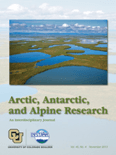
ARCTIC ANTARCTIC AND ALPINE RESEARCH
Pioneering Research in Extreme EnvironmentsARCTIC ANTARCTIC AND ALPINE RESEARCH, published by Taylor & Francis Ltd, is a leading academic journal focused on the comprehensive study of polar and alpine environments, with an emphasis on the ecological, geological, and climatic processes unique to these regions. With an ISSN of 1523-0430 and E-ISSN 1938-4246, this open-access journal has been a vital resource for researchers and practitioners since it embraced open-access publishing in 2018, fostering a wider dissemination of knowledge. Recognized in the 2023 Scopus rankings as a Q2 journal in both Earth-Surface Processes and Ecology, Evolution, Behavior and Systematics, it also attains a Q3 ranking in Global and Planetary Change, highlighting its significant impact and relevance in these fields. The journal covers a span of converged years from 1996, providing a rich archive of research that meets the evolving needs of those engaged in environmental science. By addressing pressing issues such as climate change, biodiversity, and ecosystem dynamics in extreme environments, ARCTIC ANTARCTIC AND ALPINE RESEARCH serves as an indispensable platform for scholarly exchange and collaboration among scientists, policy-makers, and educators committed to advancing our understanding of these critical areas.

Remote Sensing
Empowering Science with Open Access to Remote Sensing DiscoveriesRemote Sensing is a highly esteemed journal published by MDPI, dedicated to the domain of Earth and Planetary Sciences. With an impressive impact factor reflected in its rank of #16 out of 195 in the general Earth and Planetary Sciences category, this journal achieves a commendable 92nd percentile among its peers, indicating its significant contribution to the field. Since its inception in 2009 as an Open Access journal, it has enabled researchers, professionals, and students from around the globe to access high-quality, peer-reviewed articles that delve into the latest advancements in remote sensing technologies, methodologies, and applications. Based in Switzerland, Remote Sensing serves as a vital platform for disseminating innovative research that supports and enhances our understanding of Earth's processes and environments, ensuring scientific knowledge remains freely accessible and impactful.
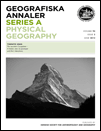
GEOGRAFISKA ANNALER SERIES A-PHYSICAL GEOGRAPHY
Fostering Insight into Our Planet's Physical RealitiesGeografiska Annaler Series A-Physical Geography, published by Taylor & Francis Ltd, is a leading academic journal dedicated to the advancing field of physical geography. With a rich publication history spanning from 1979 to 2024, this journal stands out in its categories, being positioned in the Q2 quartile for both Geography, Planning and Development and Geology in 2023. The journal is recognized for its contribution to Earth and Planetary Sciences, evidenced by its Scopus rankings placing it in the top 31% and 32% of its respective disciplines. Belonging to a distinguished publisher from the United Kingdom, it provides a vital platform for researchers, professionals, and students to disseminate and engage with cutting-edge research. While the journal does not currently offer open access, it remains a pivotal resource for those involved in the study of physical geography, offering insights that enhance our understanding of the Earth's processes and environments.
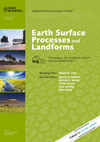
EARTH SURFACE PROCESSES AND LANDFORMS
Transforming Understanding of Earth’s Surface DynamicsEARTH SURFACE PROCESSES AND LANDFORMS is a renowned academic journal dedicated to the comprehensive exploration of dynamic processes shaping the Earth's surface. Published by Wiley, this esteemed journal has established itself as a leading platform in the fields of Earth and Planetary Sciences, Geography, Planning, and Development. With an impressive Impact Factor and ranked in the Q1 category for multiple disciplines, it consistently features cutting-edge research that contributes to the understanding of geomorphology, hydrology, and related environmental phenomena. Researchers and professionals can benefit from the journal's extensive repository of high-quality studies, making it a crucial resource for advancing knowledge in these vital areas. As it continues to converge from 1981 to 2024, EARTH SURFACE PROCESSES AND LANDFORMS remains pivotal for scholars aiming to engage in high-level discourse and discovery in Earth sciences.
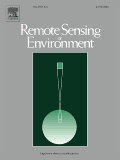
REMOTE SENSING OF ENVIRONMENT
Unlocking the Secrets of Our Planet’s Changes.REMOTE SENSING OF ENVIRONMENT, published by Elsevier Science Inc, is a premier academic journal specializing in the interdisciplinary field of earth observation and remote sensing technologies. With an impressive impact factor and classified in the Q1 category for Computer Science in Earth Sciences, Geology, and Soil Science as of 2023, this journal serves as a vital resource for researchers, professionals, and students alike. The journal, which has been disseminating high-quality research since its inception in 1969, provides a platform for the exploration of innovative methodologies and applications in the assessment of environmental changes and resource management through advanced imaging techniques. While not an open-access journal, REMOTE SENSING OF ENVIRONMENT offers access options that make cutting-edge research accessible to its audience. Its strategic focus on critical issues pertaining to environmental monitoring and sustainable practices underscores its role in enhancing our understanding of the planet’s dynamics.